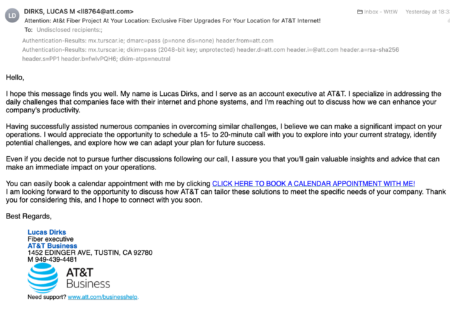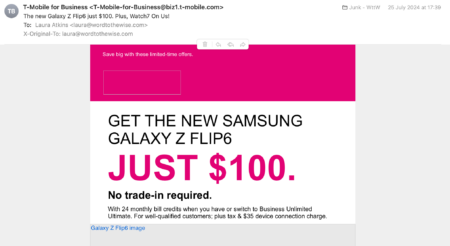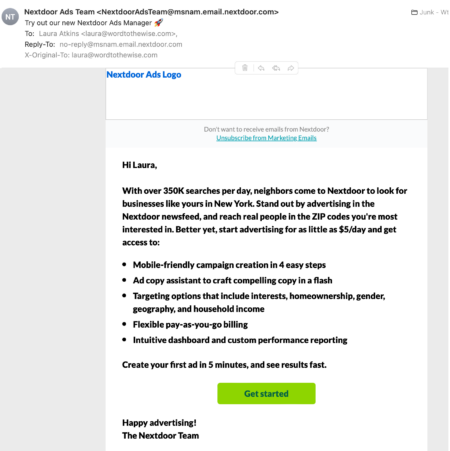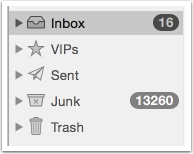The Economics of Cold Outreach
- laura
- August 12, 2024
- Best practices , Industry
It’s time we talk about cold outreach mail. In the last 2 years the volume and aggressiveness of cold outreach mail seems to have exploded. There are dozens of companies out there who are selling services to companies to facilitate cold outreach. My own sales mailbox is full of requests from companies to help them solve their delivery problems.
So let’s talk about cold outreach. It’s been on my radar for at least the last decade. Usually what happens is marketing teams reach out to me for help with delivery because their cold outreach team has been so aggressively spamming that it’s ruined their domain reputation and all their opt-in mail is now going to spam. The marketing team wants help but can’t fix anything because the outreach team keeps sending spam. The best I can do is advise the outreach team buy their own infrastructure and domains to protect the company’s opt-in mail.
More recently I’m getting a lot of inquires from the cold outreach teams themselves. They’re utterly baffled as to why their reputation is bad and they want to hire me to fix it. The reality is, though, there is nothing I can do. Their reputation is bad because most recipients think cold outreach mail is spam. They report it as spam and they block it as spam and it gets all the respect it deserves.
The thing is, companies seem addicted to cold email. Even as delivery gets harder and harder and revenue gets worse they stick with it. Then they end up paying more and building out specific cold email infrastructure and they still stick with it. There’s this entire industry that has convinced companies that cold email is the only way to get ahead and people believe them – even as their own experience demonstrates this isn’t the magic panacea.
Targeted is a myth
Most folks who are doing cold outreach argue they are sending targeted email. They are researching the right targets and sending personalized email intended to get a partnership with that person. I gotta tell you, this is a lie. A few years ago, back when I would take on the occasional client with cold emailing practices I had access to a corpus of over 100,000 “personalized” and “targeted” emails. There were maybe a dozen different boilerplates, but the text was all the same. There was nothing in those messages that looked the least bit personalized.
I might feel differently if my mailbox had any indication of actual targeting or personalization. But not one message has ever looked personalized. From the point of view of a deliverability consultant and from the person getting your emails it’s all spray and pray. Sometimes, it’s even clear where they get the “personalization” – from scraping a couple words off LinkedIn or doing a word search on the blog.
Some companies do even less than that. They buy data from brokers and use that to send their spam. But the data is really bad and not at all accurate.
Bad data all the way down
Take, for instance, the targeted email I received from ATT this morning offering me AT&T business fiber to my location.

I included the authentication results in the screenshot to confirm that this isn’t some random affiliate spamming for AT&T but an actual DMARC passing email from att.net.
This is the type of quality, targeted mail that I regularly get. I mean, also this morning Michael Clark from keyb2bleads.com tried to sell me the National Funeral Directors Association – NFDA Visitor’s list.
I had a parenthetical at the end of the last paragraph about how I’d spare you the screenshot from the NFDA Visitor’s list spam and a suggestion you go see the keyb2bleads.com website and see it was just a parked domain – how professional!. I was going to treat it as a cute aside, but as I was working on the bottom of the post I got a email notification that he sent me ANOTHER email – about 15 hours after his first. This was him asking me if I’d had a chance to consider the purchase and asking me to pick a number to reply. I also discovered that his colleague Nancy reached out to me about the same thing 3 hours before he did. This is why we call it spam. (And, Michael, if you’re reading this: 2. The answer is 2 – “just close my tab” but, really, if you were a half decent marketer you would have said “close the coffin on this lead” c’mon, put in some effort, dude.)
segue over… back to the post.
AT&T aren’t the only big brand jumping on the B2B spam cold outreach wagon. T-mobile have been sending me an ongoing drip campaign trying to sell me business internet and Samsung phones, too.

This is coming from Sprint owned IP space, so I have to assume it’s legitimate. Unlike AT&T the message isn’t DMARC passing and they’re mailing from biz1.t-mobile.com which has no MX. However, the domain does have a valid SPF record and a valid DMARC record. The DNS records are all in the t-mobile zone so someone at t-mobile authorized use of this domain.
I’m sure folks are saying that wordtothewise.com has a business presence in California so clearly this is just slightly mis-targeted and that I am over reacting to simple mis-directed mail. But that’s my whole point: this type of outreach mail is often so mis-targeted it’s nothing more than spam. There is no research or personalization. It’s Just Spam.
I don’t just blame the companies buying data. I blame the companies selling the data, too. Take this recent message I got from Nextdoor pitching their local New York advertising to me.

Nextdoor actually has a presence here in Dublin, so I reached out to their privacy team to find out what information they had on me and where they bought it. The DPO was very helpful and replied to my initial request telling me that wasn’t the EU team, that was just the US group. Over the course of a few emails and a couple week, they finally made contact with the US team and discovered that my faulty information was purchased from Data Axel. They did assure me that they asked their US team to delete my record, which I’m sure will work until they rebuy my data.
But it works… until it doesn’t.
Proponents of cold outreach claim it’s effective. I’ve had clients tell me that their upper management teams will not stop or slow down cold outreach even as it’s damaging their domain reputation. Sometimes the reputation damage is so bad it affects the to the point that the CEO is getting reports their personal mail is going to spam with vendors, clients and even VCs. That tends to inspire the call to me.
The calls are reliably the same: We need to know how to tell people our mail shouldn’t be in spam. My answers are reliably the same: Why shouldn’t your mail be in spam? Your mail should be in spam until you stop sending mail your recipients think is spam. As far as your other mail, when the bulk of the mail you are sending is spam, that drives your domain reputation down. You can’t repair your reputation as long as your outreach team keeps sending mail users report as spam.
I’ve stopped taking on these types of clients. What they’re looking for is a The One Trick Deliverability Won’t Tell You About that will convince filters that the mail isn’t spam. I’m here to tell you: no one has told me what that trick is, I don’t have it, I can’t tell it to you. My advice for deliverability hasn’t changed: Send mail people have asked for and want. Focus on the value you’re bringing to the recipient.
Cold outreach mail doesn’t bring value to the majority of the recipients. A few months ago I turned down an opportunity to help a company expand their cold outreach program. In their proposal to me they gave me the following sales goals:
- Our targeted # of accumulated decision-maker emails by employee company size ranges can expand from our current 900,000 plus emails sent out every 3 weeks to a minimum of 4 million unique emails over 3 years to 12,000,000 million over 3 years. It will depend on the quality and results of the emails.
- Results are measured by the leads we get as well as how many emails we purchase that are good or cause us problems in the delivery.
- The number of 3 week cycle leads from emails is to receive a minimum of 9 to a goal 15 leads from 4 million emails. With 12 million emails every 3 weeks, we would hope to receive a minimum of 27 leads with a goal of 45 leads.
Elsewhere in the message they’re saying their goal is that each contact get only one email per 3 week cycle. Their stretch goal for leads is 45 leads after sending 12 million emails. They’re willing to email 12 million people in order to get 45 leads. That’s not targeted. That’s spam. That deserves to be blocked and I support any recipient filter or domain that blocks them.
But it’s legal
So?
No. Really. So What? There are a lot of things that are legal but are bad ideas. The laws cannot and do not capture what is good or right. The law is the floor. The bare minimum you need to do to avoid punishment by the government. There’s a lot of random blog posts around that claim lawyers have said privacy laws like GDPR do not apply to business information and many businesses have taken that onboard. I can’t seem to find any actual Government saying that, but perhaps I’m just looking in the wrong places.
But, and here’s the crux of it: I own my mailbox. I pay for the domain it’s on, I pay for the hardware it runs on, I pay for the people to maintain it. Mine. If I decide I want to block you because I don’t like the color of your mail I get to do that.
The domain and mailbox owner’s control over their own property is why it is so hard to get blocks removed in the cold email situation. That’s why a lot of deliverability folks, including myself, refuse to work with cold email. Fundamentally, the block is perfectly justified and even if it wasn’t, the sender doesn’t have any legitimate argument to be able to access employees of a company.
Cold email is self limiting
A lot of the spamming choice is due to limited budget. Companies don’t want to pay for marketing and email is cheap, so email it is. The reality is spam works for a while. My experience, though, is that there are decreasing returns for spamming projects. Cold outreach can bring in money and it can bring in money for early stage companies particularly. But it’s not sustainable for the long term. At some point, companies need to be mature enough to wean themselves out of the idea of sending 12 million emails to get 45 leads in 3 weeks.
I’m also seeing a lot less tolerance on the part of filters, both outbound and inbound. According to folks I talk to Google is cutting outreach mail off – both with individual accounts and by disconnecting API access for some of the outreach deliverability companies. Recipients are certainly getting more and more frustrated with outreach mail and are reporting it as spam to their IT departments and filtering providers.
I’m not naive enough to believe spam, even the cold outreach type is going to go away.
Deliverability strategies for cold email
One of the big problems cold emailers have is reaching the inbox. I’ve even seen some LinkedIn posts suggesting that us deliverability people could make bank if we’d just help the cold emailers get their mail in the inbox. I’ve seen other discussions on LinkedIn expressing confusion and surprise that deliverability experts won’t help cold emailers.
The answer is pretty simple: many deliverability folks hate spam and see no real difference between cold emailers and spammers. We’re not going to waste our time giving advice that won’t work because the client won’t listen to the most important recommendation: send opt-in email.
But don’t despair. There’s an entire industry of deliverability folks who will take spammer money and who will try and help cold emailers. Many of them have slick, modern, websites with fancy graphics talking about their skills and how they can help senders set up authentication and get mail into the inbox. I’m sure they can do all this: authentication is the easy bit and spammers have been capable of setting up fully DMARC compliant email for years.
There are also entire platforms and SaaS companies that will help you get your mail to the inbox. Warmup services, inboxing services, and last week I even saw one that sells you a platform to manage hundreds or thousands of domains either on a dedicated IP or on “distributed infrastructure”.
Cold emailers don’t really need my advice, although WOW do they get shirty when I tell them I can’t and won’t help them. I try and be as professional as possible saying things like: “The processes I use to get mail delivered work primarily on opt-in email. I have found that they don’t work well in the cold email space. Because of that I no longer accept cold emailers as customers.” I continue to be amazed at the amount of pushback and just generally rude responses I’ve gotten to that. They beg and argue and tell me they’re sure that they’re different. They’re not and they’re never happy with the advice I give anyway.
What replaces cold email
I saw another person on LinkedIn take people like me to task. We spend a lot of time saying no, don’t do cold outreach mail, it’s spam. But we don’t provide any alternatives. I understand the perspective. It’s standard techniques in positive reinforcement training – redirect the poor behavior into an acceptable behavior. If you want the cat to stop scratching the couch, it’s more effective to redirect them to somewhere they’re allowed to scratch then just yell at them.
The thing is, marketers aren’t cats and they know all the reasons to not use cold outreach mail. They understand the reasons we’re saying no. They don’t need to be redirected, they’re making specific choices to continue to spam. Sure, their bottom line looks good, until it doesn’t. Their deliverability is good, until it isn’t. Their cold outreach is good, until it isn’t.
I’d assume anyone who is trainable would take the hint from having to set up thousands of domains and buy an entire infrastructure just to maintain their inboxing. The spam filters are filtering mail because the recipients say it’s spam. Instead of learning from that and identifying non spam ways to market, they double down on the spam and invest in tools and strategies that let them avoid the consequences of their actions.
They don’t want advice that works. Because the advice that works is to stop sending spam and get people to give you their email addresses and then market to an opt-in group. They don’t want to hear it. There are thousands of blog posts about how to send opt-in mail. It’s not that we’re hiding some secret, it’s that cold mailers ignore any advice that means they may have to spend effort or money.
I’m not a marketer. I can come up with ideas. I can give suggestions. But I don’t have the expertise to give advice to marketers on how to market their product. What I am is a deliverability expert; I give advice on how to get mail delivered. Start with sending mail people have asked for rather than just buying random addresses or scraping websites. I don’t help spam get delivered, even when it’s the only thing propping up your failing business.
